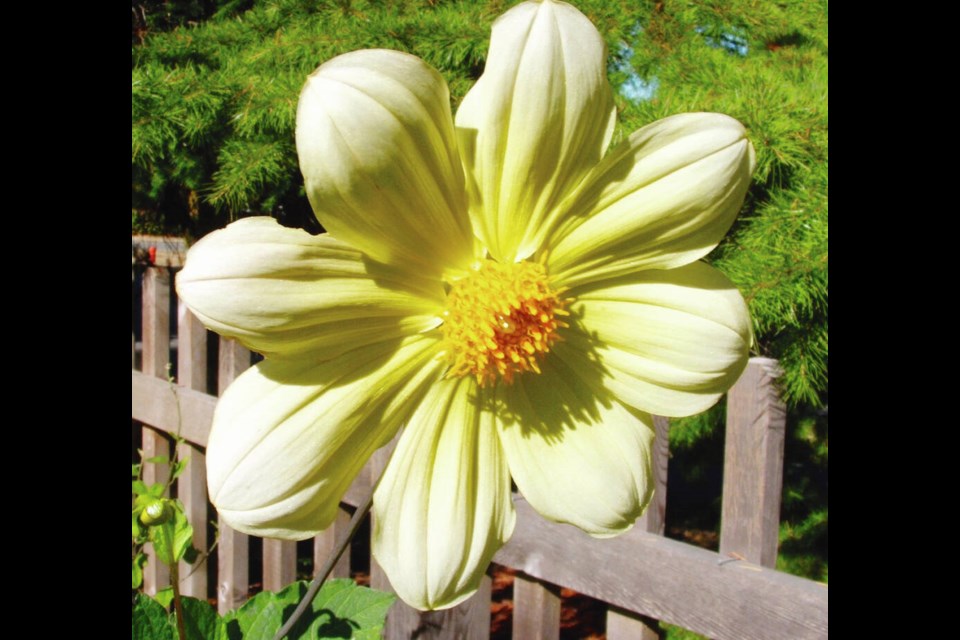Dear Helen: I admired the pink dahlias pictured in one of your October columns. I’m currently looking for attractive dahlias that carry plenty of pollen for the bees. Are your pink dahlias called Helen Richmond? I used to grow that variety, and remember it as a fine dahlia.
J.S.
A friend gave me the tuberous roots for my pink dahlias years ago. She called the variety Pink Audrey. I’ve not been able to find a dahlia of that name. The closest one to it is Clearview Audrey, which grows to a similar height at around 1.5 metres, and the flowers are of a similar form though in a lighter shade of pink than mine.
My pink dahlias have the traits of dahlias in the Semi-Cactus class, characterized by petals that are broad at the flower centre, becoming rolled into a quill shape toward the tips. Helen Richmond has the tidier, more formal look of the Decorative class of dahlia.
If it is pollen you are looking for in dahlias, avoid these double-flowered varieties and choose single-flowered ones instead. One of the best is Bishop of Llandaff, a metre-tall, dark-leaved plant bearing single to semi-double flowers in bright red.
Dear Helen: A potted cyclamen I was given recently is already starting to wilt, even though it has been kept well watered. What to do?
P.L.
Potted cyclamen plants will retain sturdy stems and leaves, and perky flowers, only in cool temperatures. Warmth triggers dormancy. If possible, move the plant to a bright window where temperatures are cool, ideally in the 10 C to 16 C range. Keep the soil modestly moist, watering around the pot rim and not onto the tuber.
In congenial conditions, potted cyclamens will give a prolonged period of bloom before starting to die pack. At that point, you have the option of discarding the plant or keeping it to re-grow and bloom again.
Post-bloom care with the prospect of another bloom season is not onerous or complex. Gradually reduce water to the fagging plant and remove growth that has withered. Do this by gentle pulling, not cutting.
Once all top growth is gone, store the pot in a cool place, providing only the occasional, light watering to keep the tuber from shrivelling.
Set the pot outdoors in a sheltered spot in the spring and repot when the first bit of top growth appears. Position the tuber with its surface at soil level. Find a cool spot in light shade for the plant, water regularly, and watch for the first flower buds forming as the weather cools in early autumn.
Bring the plant back indoors as overnight low temperatures begin approaching 10 C or when the plant has developed a nice collection of buds — whichever happens first.
Dear Helen: I read with envy your recent column about enjoying the kale in your garden. This vegetable does not do well for me. I have good soil, well limed and enriched with compost, but the transplants I set out in September hardly grew at all.
R.S.
The timings often given for seeding and transplanting kale do not work well in every garden. For plants that are large by fall, and full of greens to see me through the winter, I seed indoors in March or early April for transplanting in April or May.
In some years, when I’m falling behind with the indoor seeding, I’ll sow kale outdoors in April or early May.
An early July sowing or early August transplanting will work too, but the plants will be smaller and the heat of summer can be a problem for seedlings. Spring planting allows the kale to get a good start before the heat arrives. Kale plants do lose their perkiness in the summer heat, but they revive with cooling weather and become sweet-tasting in cold temperatures.
Your September transplants might have done better if the weather hadn’t cooled so rapidly, depriving us of our usual long, warmish early autumn season.
Because I leave kale plants to flower and feed the bees in late winter and early spring, some shed seeds and I usually have self-sown plants. The “volunteer” seedlings appear in April in my garden. These plants are always the strongest and most productive, and the timing of their appearance is a helpful guide to the best planting time in my conditions.



